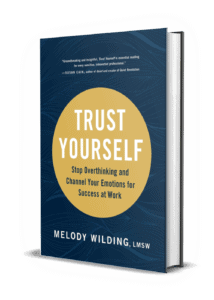Setting boundaries at work is more important but harder to achieve, than ever before. You may be afraid of saying no to your boss, for example, or be fearful that setting boundaries with your colleagues will make you appear as if you’re not a team player. Even just learning how to define healthy boundaries at work can feel overwhelming.
These concerns are even greater for a group of professionals known as Sensitive Strivers. Sensitive Strivers are high-achievers who think and feel everything more deeply than others. As leaders, they are kind-hearted, helpful, and endlessly dedicated. They readily put the needs of others ahead of themselves. While these qualities are admirable and contribute to Sensitive Strivers’ success, overextending yourself can also lead to stress, burnout, and can even create self-doubt about your own capabilities.
Benefits of Setting Boundaries at Work
Whether or not you relate to being a Sensitive Striver, setting boundaries at work is one of the most important skills you can master, especially in a world with increasing workloads and non-stop demands.
After all, healthy limits free you up to interact with others in productive ways to respond to demands on your time and energy and to focus on doing work you enjoy. In other words, boundaries exist to help you say “no” to situations, people, and goals that you don’t want or don’t serve you, so you can say “yes” to ones that do.
Setting boundaries at work can help you:
- Increase your confidence and self-esteem because your value your desires and preferences
- Create stronger relationships based on mutual respect with your boss, co-workers, clients, and collaborators
- Achieve career gains like a higher salary, a promotion, or greater responsibility and influence.
Take a moment to think about how your life would change if you set stronger boundaries at work? What would be possible?
The Importance of Setting Boundaries at Work
Put simply, boundaries the physical, emotional, and mental limits you create to protect yourself from over-committing. Think of boundaries as rules that govern your time and energy.
General speaking, there are two categories of boundaries:
1. External.
You’re likely more familiar with external boundaries, which include setting limits around our time, bodies, and personal space. External boundaries are ones we set between ourselves and the outside world. They’re usually easier to understand because they’re tangible and more visible. For example, external boundaries related to work could include:
- Choosing to end work at a certain time
- Setting limits around how often you check email
- Closing a door when you need to concentrate
2. Internal
Internal boundaries are limits that govern your mental and emotional worlds and regulate how you think and feel. Think of them as the limits you set between you and yourself. Your internal boundaries toggle what information you internalize, the perspectives we take, how long or much you let something affect you, and how you choose to act as a result. People with strong internal boundaries have a strong sense of identity and self-respect. They’re able to say no to unreasonable requests and don’t allow others’ moods to easily influence their own. For example, internal boundaries related to work could include:
- Honoring the goals you set for yourself
- Practicing healthy detachment from worries and criticism
- Being curious and open-minded when new ideas are presented in a meeting
Setting boundaries at work means you must also be adaptable in your approach.
Someone who is aloof with their co-workers or who shies away from social events at work may have rigid boundaries. These people throw up walls to protect themselves from getting hurt or appearing vulnerable. But ultimately these rigid boundaries backfire. They prevent them from developing the relationships they need in order to advance in their careers.
On the other hand, you don’t want your boundaries to be too porous (i.e. never saying no, agreeing to every request, etc.). A healthy boundary is a flexible one that allows you to exercise control over what you let in or allow but does not make you overly defensive or resistant to change.
Free BOOK CHAPTER
Turn your sensitivity into a strength and regain your confidence at work
Get exclusive access to Chapter One of my book, Trust Yourself: Stop Overthinking and Channel Your Emotions for Success at Work.
By submitting this form you consent to receive newsletters and promotions via email. Unsubscribe or opt-out any time. See our Privacy Policy.
How to Set Boundaries at Work
Creating healthy boundaries at work can be difficult because there’s the real worry of being demoted, fired, or disliked. Yet with clear communication and practice, you can learn to set self-honoring limits without alienating people or losing your paycheck.
Figure out where limits need to be set and define what needs to be changed.
When I work with coaching clients who feel like work is consuming their lives, we first conduct a boundary audit. This involves paying attention to people, situations, and personal actions that cause them distress or discomfort. In particular, experiencing patterns of four key emotions — tension, resentment, frustration, and discomfort —signal a boundary has been crossed, needs to be reset, or needs to be communicated more clearly.
Define what needs to change.
After you have gained insight into problem areas, define your new boundary. Make a request of yourself or another person about what needs to change. For example, you might ask your direct reports to drop by your office only during pre-set office hours rather than at all times of day. Or you may make a pact with yourself to contribute at least once during a meeting instead of sitting silently.
Communicate clearly.
Healthy boundaries aren’t meant to punish; they’re meant to be mutually beneficial and supportive. If you have to set a boundary with another person, think of approaching the conversation like a negotiation. Ask your boss, partner, or whoever you’re speaking with to describe the situation from their perspective as well to keep the lines of communication open. You need to understand the other person’s needs and desires in addition to being up-front about your own perspective. Don’t get defensive; communicate assertively. Avoid accusatory language like “it’s not fair” and instead focus on making “I” statements that show you take responsibility for your actions.
Prepare for pushback.
Once you start establishing healthy expectations, others may react negatively. Boundary-crossers may get angry. This is to be expected. It’s a sign that the boundary is necessary and that it’s working effectively. Instead of viewing violations as setbacks, see them as opportunities to gain insight and improve on your boundary-setting. It’s helpful to anticipate these moments of violation. Visualize your boundaries getting crossed and imagine how you’ll handle those situations. This way, when a moment like this comes up, you won’t be hijacked by your emotions. You’ll be able to handle it more rationally.
Setting boundaries at work takes time and practice. It may be nerve-wracking at first, but setting self-respecting limits will help you achieve a more balanced work and personal life over the long run.
Free BOOK CHAPTER
Turn your sensitivity into a strength and regain your confidence at work
Get exclusive access to Chapter One of my book, Trust Yourself: Stop Overthinking and Channel Your Emotions for Success at Work.
By submitting this form you consent to receive newsletters and promotions via email. Unsubscribe or opt-out any time. See our Privacy Policy.









